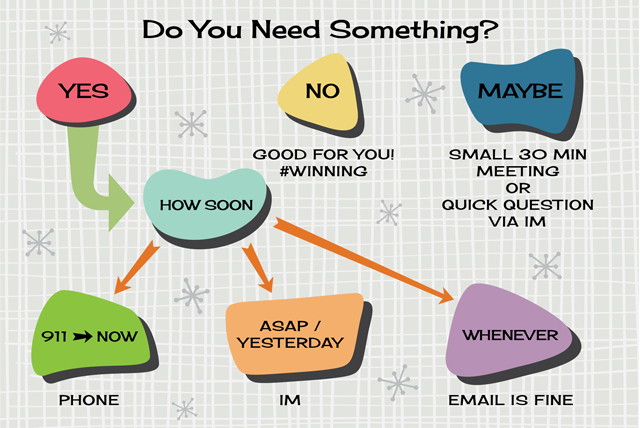July 15th, 2022
Make friends, influence people and get more done NOW with these communication hacks.
- Choose the right tool for the job. The job = YOUR desired outcome.
- Use your employer’s Instant Message platform (Teams, Slack, Zoom or similar) If you need a fast answer, solution, or favor— especially the same day. Same goes for any ‘stop the presses’ urgent news or announcements. Your teams will thank you for the timely heads-up … and for not clogging up their inboxes.
- Send email when you need to:
- Notify groups of decisions/action items
- Recap next steps/responsibilities after a meeting
- Formally announce policy changes
- Loop in external recipients like clients or vendors
- DO NOT USE EMAIL to ask open-ended questions or as a forum for discussion or consensus-building. Fact: Since IM happened, even work emails often sit for hours or days before being read.
- Call a meeting or pick up the phone. Once an email chain sprouts its third round of responses, it’s time to talk. There’s a reason many Fortune 500 companies have this as a rule of thumb: it saves time, cuts inbox clutter and lowers the potential for error. Many complex questions or problems require a conversation to reach a solution.
Gone are the days when only juniors or assistants scheduled meetings! Whoever needs the answer or has the most at stake should set it up. Built-in “Schedule Assistant” tools in Outlook, Teams and most other comms platforms make it easy to find times when all parties are available.

- Be informal, but polite.
- Please and thank you have never gone out of style, and they still go a long way toward eliciting cooperation and building relationships.
- Don’t lead with “Dear” unless paper is involved, but say “Hi/Hello” before “name” in an email salutation — unless you’re going for an adversarial vibe. You do you, but leading with “Name,” definitely does set a tone.
- Subject lines are your friends: treat ‘em right and they’ll do you favors.
When your colleagues look at their email inboxes, they react like anybody else — they skim subject lines and look for fires first. The most common mistake is also the most dangerous: a subject line that’s so unspecific and un-searchable, you might as well not have one at all.
Lousy subject lines include lone job numbers, project names and repeat offenders like:
- One more thing
- Followup items
- Client feedback
- Before I forget …
- Just putting this out there
- Passing along message from
Want your colleagues to answer your emails first? Put your subject lines to WERK, honey, with clear, urgent, specific leads. Try these beauties on for size:
- ACTION NEEDED:
- Schedule at risk, outstanding questions
- Respond by EOD to make deadline
- 911, <name>
Want your colleagues to answer your emails first? Put your subject lines to WERK, honey, with clear, urgent, specific leads.
- Ask for what you need, or you will not get it.
Think about this the next time you write any piece of communication: unstated needs, expectations and desires cannot be satisfied — unless by accident.
There is an excellent chance your colleagues have spent the last several hours or days solving complex, stressful problems completely unrelated to you. Help them help you as quickly and easily as possible. Be clear, be concise, and be appreciative.
Voilà: “Hello Sally, I need your help, please. I need X by Y o’clock to accomplish Z on deadline. Are you the right person to bug or can you point me at that person? Thanks in advance for any assistance you can provide!”
Was that so hard? You just exponentially improved your chances of success, simply by asking a deliberate, specific question — and setting a deadline for their answer.
- Provide ALL the information needed to solve your problem or answer your question — at their fingertips, within the same communication.
There is a special circle of heck (that’s right! I said it!) for people who forward 30-email threads and force the recipient to read them all to figure out what to do next. Decoding that can take hours, the reader quietly cursing under their breath all the while. Just say ‘NO’ to the Toxic Forward™. We can end it, here and now.
Ask for exactly what you want by when. If you refer to a prior asset or effort, link to a PDF or provide a thumbnail. If you need fast content, provide starter references. Failure to do so constitutes a transfer of labor: You’re making your recipient hunt down stuff you didn’t, which takes time — shrinking your window for success.
While they are compiling specifics you could’ve provided, your colleague can easily be distracted by another coworker with an even hotter fire … or a gleeful toddler holding peanut butter and jelly in one fist and a toy truck (plus some residual jelly) in the other. At that point, all bets are off. Your thing may never happen.
If your colleague had all the info they needed to answer your question, the turnaround for your solution could’ve dwindled to almost nothing. You’d be way ahead of the game. Maybe even finished. Maybe you’d be sipping a fruity drink under an umbrella on vacation already … ok, ok, I digress. But you get my point.
Let’s face it: The past two years just weren’t in the playbook. We’re all learning new ways to collaborate with colleagues, even as we’re re-learning old-fashioned manners, how to mingle with strangers and more in the age of COVID.
If you’re a remote or hybrid worker, please feel free to give these communication tips a try. I hope you find them helpful in winning back more time to enjoy the summer weather!
Blog written by Caroline Steiner | Vice President and Creative Director

